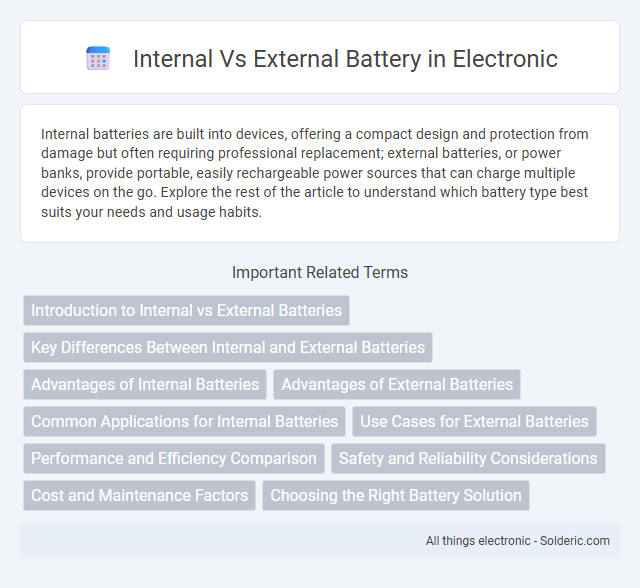Internal batteries are built into devices, offering a compact design and protection from damage but often requiring professional replacement; external batteries, or power banks, provide portable, easily rechargeable power sources that can charge multiple devices on the go. Explore the rest of the article to understand which battery type best suits your needs and usage habits.
Comparison Table
| Feature | Internal Battery | External Battery |
|---|---|---|
| Location | Built inside the device | Separate portable unit |
| Portability | Fixed, non-removable | Highly portable and detachable |
| Replacement | Requires technical support | Easy to replace or upgrade |
| Lifespan | Typically 2-3 years | Varies by model, replaceable |
| Charging Method | Charged via device power source | Charged independently via USB or wall outlet |
| Use Cases | Powering the device itself | Backup or extended power on-the-go |
| Cost | Included with device purchase | Additional purchase required |
| Power Capacity | Limited by device design | Varies widely, often higher capacity |
Introduction to Internal vs External Batteries
Internal batteries are integrated into devices, providing a compact, seamless power source that supports portability and design aesthetics, while external batteries offer versatile, rechargeable power banks that can charge multiple devices on the go. Your choice between internal and external batteries affects device performance, convenience, and battery life management, with internal batteries often offering optimized energy use and external batteries enhancing flexibility and backup power. Understanding the distinction helps you select the best power solution tailored to your specific electronic device needs and usage patterns.
Key Differences Between Internal and External Batteries
Internal batteries are built into devices, offering compact design and optimized power management while limiting user replaceability and capacity upgrades. External batteries, such as power banks, provide portable, high-capacity power sources that expand device runtime across multiple charges and models but require separate carrying and connection. The key differences lie in integration, portability, capacity flexibility, and ease of replacement.
Advantages of Internal Batteries
Internal batteries offer a streamlined design that protects the power source from environmental damage and tampering, enhancing device durability. They reduce overall device size and weight by eliminating bulky external compartments, improving portability and aesthetics. You benefit from integrated charging systems that often provide faster and more efficient power management compared to external battery setups.
Advantages of External Batteries
External batteries offer significant advantages including portability and easy replacement, allowing users to charge devices on the go without needing access to power outlets. They provide additional power capacity, extending device usage time during travel, outdoor activities, or emergencies. External batteries also reduce wear on the internal battery by minimizing frequent charging cycles directly from the wall.
Common Applications for Internal Batteries
Internal batteries are commonly found in smartphones, laptops, and wearable devices due to their compact design and ability to provide consistent power without user intervention. They are also widely used in medical implants and portable electronics where sealed, non-removable power sources enhance device reliability and safety. Your choice of devices with internal batteries ensures a lightweight, sleek profile and convenience through integrated power management.
Use Cases for External Batteries
External batteries are essential for outdoor activities, travel, and emergency situations where power outlets are unavailable, providing reliable energy on-the-go for smartphones, tablets, and laptops. Their portability and high capacity support multiple device charges, making them ideal for long days away from home or office. Your convenience and productivity remain uninterrupted with an external battery designed for versatile and extended use.
Performance and Efficiency Comparison
Internal batteries typically offer higher performance and improved energy efficiency due to their integration with the device's hardware, enabling optimized power management and faster charging cycles. External batteries, while providing additional capacity and portability, may suffer from energy loss through connectors and often experience slower charging speeds, reducing overall efficiency. Devices powered by internal batteries generally maintain more stable voltage and current levels, enhancing operational reliability compared to external battery use.
Safety and Reliability Considerations
Internal batteries offer enhanced safety through integrated protection circuits that monitor temperature, voltage, and current, reducing risks of overheating and short circuits. External batteries provide flexibility but may introduce connection vulnerabilities that affect reliability and can pose safety hazards if connectors degrade or are improperly handled. Proper maintenance and using certified batteries significantly impact the safety and longevity of both internal and external power sources.
Cost and Maintenance Factors
Internal batteries generally entail higher initial costs due to integrated design and replacement complexity, often requiring professional service. External batteries offer more affordable upfront prices and simpler maintenance, as you can easily swap or upgrade them yourself. Your choice impacts long-term expenses and convenience, with external batteries typically favoring lower maintenance and cost flexibility.
Choosing the Right Battery Solution
Choosing the right battery solution depends on the device's design, usage, and maintenance preferences. Internal batteries, often lithium-ion, provide a compact design and longer lifecycle but require professional replacement, while external batteries offer easy swap options and extended usage time without technical support. Evaluating factors such as device portability, power requirements, and user convenience ensures selecting the most efficient and practical battery type.
Internal vs external battery Infographic

 solderic.com
solderic.com